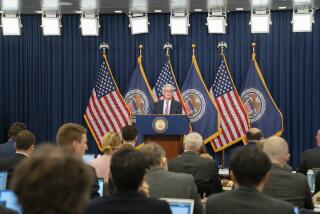Geithner says he acted appropriately on LIBOR at New York Fed
WASHINGTON — Treasury Secretary Timothy F. Geithner told lawmakers Wednesday that he acted appropriately as president of the Federal Reserve Bank of New York when he learned in 2008 that a key international interest rate could be manipulated by large banks.
But despite concerns that the London Interbank Offered Rate, or LIBOR, was vulnerable to under-reporting by banks at the time, Geithner said he and other Fed officials felt it was not a problem to use the rate to set the terms for the $182 billion bailout of American International Group and a $1-trillion emergency lending program called the Term-Asset Backed Securities Loan Facility.
“We, like investors around the world, had to take advantage of the rates available at that time, and we chose LIBOR at the time like many others,” Geithner told the House Financial Services Committee as he testified for the first time about the rate-rigging scandal.
Geithner said it was not clear if taxpayers paid more for those bailouts because the interest rate was rigged. But Rep. Jeb Hensarling (R-Texas) said he didn’t understand why the Fed used LIBOR to set the terms of those bailouts given concerns that it was not legitimate.
“How can a number that you know has been manipulated, how can that possibly be the best choice?” he asked Geithner.
Geithner said all the Fed knew at the time was that the rate was vulnerable to manipulation, but decided it still was the best rate to use.
“I think that was the right choice back then,” Geithner said.
Last week, Federal Reserve Chairman Ben S. Bernanke called LIBOR “structurally flawed” and suggested it should be replaced as a benchmark for setting interest rates.
British investment bank Barclays in June agreed to pay $450 million to settle rate-manipulation charges filed by U.S. and British officials, whose investigation is continuing. The New York Fed regulates Barclays’ U.S. operations.
The House Financial Services Committee has launched it own investigation into LIBOR rate-rigging, requesting documents from the New York Fed.
Some of those documents released this month showed the New York Fed learned from a Barclays employee in the spring of 2008 that the bank was under-reporting its borrowing costs to pull down LIBOR. The employee said other large banks were doing the same thing.
Geithner said Wednesday that he learned of the concerns at the same time and notified top U.S. officials, including the heads of the Treasury Department, Securities and Exchange Commission and the Commodity Futures Trading Commission, which launched the investigation that resulted in the Barclays settlement.
“We were aware of the risk that the way this was designed created not just the incentive for banks to under-report but gave them the opportunity to under-report, and that was a problem,” Geithner said of LIBOR. “I believe we did the necessary and appropriate thing very early in the process.”
The New York Fed also sent recommendations to the private British bankers group that sets the rate and to British regulators for improving the transparency of the LIBOR rate-setting process. It was their responsibility to fix LIBOR, he said.
Rep. Barney Frank (D-Mass.) noted that the top U.S. financial regulators in 2008 were Bush administration appointees.
“There’s been an effort to kind of blame you for all of this,” Frank said. “You were important, but not that important.”
But Hensarling said he didn’t think Geithner responded strongly enough to the concerns about LIBOR in 2008.
“It appears you treated it as a curiosity or something akin to jaywalking as opposed to highway robbery,” Hensarling said.
ALSO:
House panel probes banks’ alleged role in LIBOR-fixing scandal
Barclays to pay more than $450 million in interest-rate settlement
Bernanke says LIBOR is ‘structurally flawed,’ defends Fed’s response
More to Read
Inside the business of entertainment
The Wide Shot brings you news, analysis and insights on everything from streaming wars to production — and what it all means for the future.
You may occasionally receive promotional content from the Los Angeles Times.











